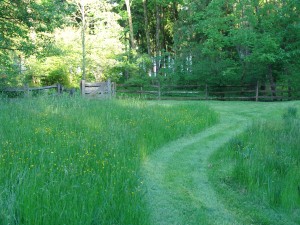The trend is growing. Longwood Gardens has a meadow. Mt Cuba Center has a meadow. Winterthur has several meadows. Isn’t it time YOU manage a meadow too? As people become concerned about pollinators and bee decline or just want to see more songbirds in their gardens, they are turning to landscaping with native plants and one of the cheapest and easiest ways to get more native plants in your landscape is to manage a meadow. Dr. Doug Tallamy, professor of Entomology in the College of Agriculture and Natural Resources at UD and author of bestseller, Bringing Nature Home, was the keynote speaker at the recent American Society of Horticultural Sciences meeting in Atlanta Georgia earlier this month. He spoke about the role native plants play in supporting native insects and more importantly life as we know it. His talk was the buzz of the meeting (no pun intended).
I just met with a couple who live in Middletown, DE on about 5 acres. They are tired of cutting grass and managing a lawn plagued by crabgrass. Instead, they plan to focus on maintaining a small healthy lawn right around the house where they want to entertain and play sports. The rest of the property is destined for meadow and maybe ultimately a forest. They started last week manipulating hoses to get the mow lines for the meadow just right. Then, they plan to kill the existing turf with glyphosate (sold as Round Up or other generic products). They will core cultivate to open up holes in the soil and improve seed/soil contact when they seed. They may use the sawdust method, which involves mixing meadow seed with sawdust and spreading a one-inch layer over the entire site. The sawdust provides a good germination medium for the seed and prevents light from reaching crabgrass and foxtail seed reducing their germination and encroachment into the new meadow. The best time to seed a meadow is late spring, but now is a great time to start deciding where your meadow will go. Just stop mowing the sections of your lawn that you want to turn into meadow and see how it looks. You will get a sense of the shape and feel of the meadow, before it is time to seed next spring. The gardens I mentioned earlier do a great job of using cues of care to indicate meadow management. Mow edges around your meadow and mow curving paths through the meadow. You can add artwork to the meadow or plant native perennials at key intersections or edges.
I have a bee-keeper friend who is taking the simpler route to meadow establishment. He simply stopped mowing his lawn. He is still mowing a circular area off the back patio, but the rest of the backyard is starting to grow tall and will hopefully provide nectar for his bees in a year or so. He needs to apply those same cues of care, by mowing a path from the end of the driveway to the mowed section. The clean crisp line between mowed grass and meadow is critical. It will take a bit longer to establish a native plant meadow with this method, but eventually native warm season grasses and perennials, like common milkweed, will grow. A middle-of-the-road strategy to jump start the meadow is to open up the soil and plant pockets of native grasses and perennials, either from seed or plugs into the now tall lawn. These plants will eventually produce seed and spread into the surrounding meadow. You can’t just throw seeds onto an existing lawn, though and expect them to germinate. Only seed that stays moist and is in contact with the soil will grow.
To manage a meadow, plan to mow once a year in early spring, and possibly again in late June. This will keep woody plants from taking over the meadow and still allow the native plants to flower. Jump on the meadow bandwagon; do your part to encourage wildlife; and help provide the ecosystem services we need right in your own home landscape!


